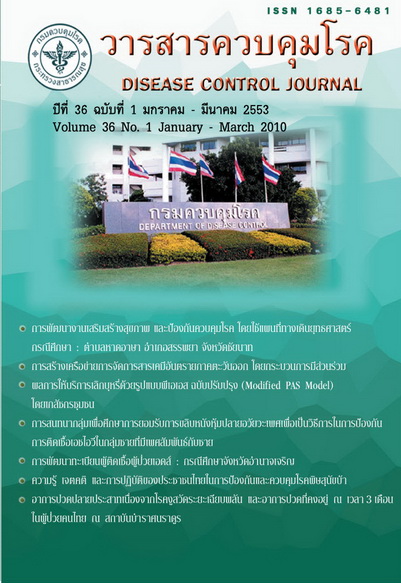Focus Groups to Study the Acceptability of Male Circumcision as a Measure to Prevent HIV Infection Among Men Who Have Sex with Men in Thailand
Keywords:
Male circumcision, men who have sex with men, HIV, focus group discussion, ThailandAbstract
This study investigated the acceptability of male circumcision (MC) as a measure to prevent HIV infection among men who have sex with men (MSM) in Thailand. Six focus group discussions were conducted during November 2007 to February 2008. All 41 participants were recruited. Socio-demographic and sexual behavioral data were collected using a short-questionnaire. Atlas.ti version 4.2 was used in data analysis. It was found that there were 6 barriers to the acceptability of MC as a measure to prevent HIV infection among MSM in Thailand as follows: 1. Participants are concerned about efficacy of MC for HIV prevention, 2. Participants think that benefits of MC might not be worth going through post surgical pain, 3. Participants believe that MC can prevent HIV among MSM who perform insertive role ("top") only during anal sex intercourse, 4. Participants think of MC as a minor surgery for people with phimosis or paraphimosis, as a religious rite, or for personal hygiene, 5. Participants believe that they have other ways to protect themselves from HIV, and 6. Participants are not aware of different circumcision styles. We suggested that appropiate and accurate information of MC should be given to public. MC should be recommended to parents for newborns not only as a HIV preventive tool, but as a general hygienic matter. Condom use campaign should be promoted consistently.
Downloads
References
2. Auvert B, Taljaard D, Lagarde E, Sobngwi-Tambekou J, Sitta R, Puren A. Randomized, controlled intervention trial of male circumcision for reduction of HIV infection risk: The ANRS 1265 trial. PLoS Med 2005; 2: 1112-20.
3. Williams BG, Lloyd-Smith JO, Gouws E, Hankins C, Getz WM, Hargrove J, et al. The potential impact of male circumcision on HIV in Sub-Saharan Africa. PLoS Med 2006; 3: e262.
4. Bailey RC, Moses S, Parker CB, Agot K, Maclean I, Krieger JN, et al. Male circumcision for HIV prevention in young men in Kisumu, Kenya: a randomized controlled trial. Lancet 2007; 369: 643-56.
5. US National Institutes of Health. Adult Male Circumcision Significantly Reduces Risk of Acquiring HIV; 2006. เข้าใช้วันที่ 4 มีนาคม 2553; แหล่งข้อมูล : http://www3.niaid.nih.gov/news/newsreleases/2006/AMC12_06.htm.
6. Gray RH, Kigozi G, Serwadda D, Makumbi F, Watya S, Nalugoda F, et al. Male circumcision for HIV prevention in men in Rakai, Uganda: a randomized trial. Lancet 2007; 369: 657-66.
7. Science & Medicine. Routine Male Circumcision Could Reduce a Man's HIV Infection Risk by About 50 Percent, According to Studies Conducted in Kenya, Uganda. เข้าใช้วันที่ 3 กันยายน 2552; แหล่งข้อมูล : http://www.kaisernetwork.org/daily_reports/rep_index.cfm?hint=1&DR_ID=41653.
8. Family Health International. Does Circumcision Reduce HIV risks? Network 2001 ; 20(4). เข้าใช้วันที่ 4 มีนาคม 2553; แหล่งข้อมูล : http://www.fhi.org/en/RH/Pubs/Network/v20_4/NWvol20-4malecurcumsion.htm.
9. Cohen J. Perspective: AIDS research : Male circumcision thwarts HIV infection. Science 2005; 309: 860.
10. Kebaabetswe P, Lockman S, Mogwe S, Mandevu R, Thior I, Essex M, et al. Male circumcision: an acceptable strategy for HIV prevention in Botswana. Sex Transm Infect 2003; 79 : 214-9.
11. Short RV. The HIV/AIDS pandemic: new ways of preventing infection in men. Reproduction Fertility and Development 2005; 16: 555-9.
12. Bailey RC, Plummer FA, Moses S. Male Circumcision and HIV Prevention: Current knowledge and future research directions. Lancet Infect Dis 2001; 1: 223-1.
13. Tyndall MW, Ronald AR, Agoki E, Malisa W, Bwayo JJ, Ndinya-Achola JO, et al. Increased Risk of Infection with Human Immunodeficiency Virus Type 1 Among Uncircumcised Men Presenting With Genital Ulcer Disease in Kenya. Clin Infect Dis 1996; 23: 449-53.
14. Weiss HA, Thomas SL, Munabi SK, Hayes RJ. Male circumcision and risk of syphilis, chancroid, and genital herpes: a systematic review and meta-analysis. Sex Transm Infect 2006; 82: 101-10.
15. Centers for Disease Control and Prevention. CDC HIV/AIDS Science Facts: Male circumcision and risk for HIV transmission: implications for the United States, December 2006. เข้าใช้วันที่ 4 มีนาคม 2553; แหล่งข้อมูล: http://www.
cdc.gov/hiv/resources/factsheets/circumcision.htm.
16. Tobian AAR, Serwadda D, Quinn TC, Kigozi G, Gravitt PE, Laeyendecker O, et al. Male circumcision for the prevention of HSV-2 and HPV infections and Syphilis. N Engl J Med. 2009; 360: 1298-309.
17. Ulin PR, Robinson ET, Tolley EE, cNeill ET. Qualitative methods : a field research in sexual and reproductive health. Family Health International; 2002.
18. ชาย โพธิสิตา. ศาสตร์และศิลป์แห่งการวิจัยเชิงคุณภาพ. กรุงเทพมหานคร: อมรินทร์พริ้นติ้งแอนด์พับลิชชิ่ง; 2549.
19. เบญจา ยอดดำเนิน-แอ็ตติกจ์, กาญจนา ตั้งชลทิพย์. การวิเคราะห์ข้อมูลเชิงคุณภาพ: การจัดการข้อมูล การตีความและการหาความหมาย. นครปฐม : สถาบันวิจัยประชากรและสังคม มหาวิทยาลัยมหิดล; 2552.
20. Grulich AE, Henry O, Clark E, Kippax S, John M. Circumcision and male-to-male sexual transmission of HIV. AIDS 2001; 15 : 1188-1189.
21. Millett GA, Ding H, Lauby J, Flores S, Stueve A, Bingham T, et al. Circumcision status and HIV infection among Black and Latino men who have sex with men in 3 USA cities. J Acquir Immun Defi Syndr 2007; 15(46): 643-650.
22. Begley EB, Jafa K, Voetsch AC, Heffelfinger JD, Borkowf CB, Sullivan PS. Willingness of men who have sex with men (MSM) in the United States to be circumcised as adults to reduce the risk of HIV infection. PLoS ONE 2008; 3(7):
e2731.
23. Wawer MJ, Makumbi F, Kigozi G, Serwadda D, Watya S, Nalugoda F, et al. Circumcision in HIV-infected men and its effect on HIV transmission to female partners in Rakai, Uganda: a randomized controlled trial. Lancet 2009; 374:
229-37.
Downloads
Published
How to Cite
Issue
Section
License
Articles published in the Disease Control Journal are considered as academic work, research or analysis of the personal opinion of the authors, not the opinion of the Thailand Department of Disease Control or editorial team. The authors must be responsible for their articles.






